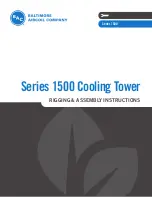
Page 27
31-5000752 Rev. 0
Homeowner Information
ELECTRICAL SHOCK HAZARD!
Turn OFF electric power to unit before performing any
maintenance or removing panels or doors.
FAILURE TO DO SO COULD RESULT IN BODILY
INJURY OR DEATH.
WARNING
Heat Pump Operation
Your new heat pump has several characteristics that you
should be aware of:
•
Heat pumps satisfy heating demand by delivering large
amounts of warm air into the living space. This is quite
different from gas-or oil-fired furnaces or an electric
furnace which deliver lower volumes of considerably
hotter air to heat the space.
•
Do not be alarmed if you notice frost on the outdoor coil
in the winter months. Frost develops on the outdoor
coil during the heating cycle when temperatures are
below 45°F. An electronic control activates a defrost
cycle lasting 5 to 15 minutes at preset intervals to clear
the outdoor coil of the frost.
•
During the defrost cycle, you may notice steam rising
from the outdoor unit. This is a normal occurrence.
The thermostat may engage auxiliary heat during the
defrost cycle to satisfy a heating demand; however,
the unit will run to normal operation at the conclusion
of the defrost cycle.
In case of extended power outage...
If the outdoor temperature is below 50°F and power to your
outdoor unit has been interrupted for one hour or longer,
observe the following when restoring power to your heat
pump system.
•
Set the room thermostat selector to the “Emergency
Heat” setting to obtain temporary heat for a minimum
of 6 hours. This will allow system refrigerant pressures
and temperatures enough time to return to a stabilized
condition.
•
In Emergency Heat mode, all heating demand is
satisfied by auxiliary heat; heat pump operation is
locked out. After a 6 hour “warm-up” period, the
thermostat can then be switched to the “Heat” setting
and normal heat pump operation may resume.
Thermostat Operation
The wall-mounted thermostat controls your heat pump.
The thermostat is available in various configurations from
different manufacturers. The information below is typical for
most thermostats. Ask your dealer for specific information
regarding the model of thermostat installed.
Fan Switch
In AUTO or INT (intermittent) mode, the blower operates
only when the thermostat calls for heating or cooling. This
mode is generally preferred when humidity control is a
priority.
The ON or CONT mode provides continuous indoor
blower operation, regardless of whether the compressor or
auxiliary heat are operating. This mode is required when
constant air circulation or filtering is desired.
On models without a fan selection switch, the fan will cycle
with the outdoor unit.
System Switch
Set the system switch for heating, cooling or auto
operation. The auto mode allows the heat pump to
automatically switch from heating mode to cooling mode to
maintain predetermined comfort settings. Many heat pump
thermostats are also equipped with an emergency heat
mode which locks out heat pump operation and provides
temporary heat supplied by the auxiliary heat.
Indicating Light
Most heat pump thermostats have an amber light
which indicates when the heat pump is operating in the
emergency heat mode.
Temperature Indicator
The temperature indicator displays the actual room
temperature.
Important System Information
•
Your system should never be operated without a clean
air filter properly installed.
•
Return air and supply air registers should be free from
restrictions or obstructions to allow full flow of air.
IF YOUR SYSTEM DOES NOT WORK, BEFORE
REQUESTING A SERVICE CALL:
1.
Ensure thermostat is set below (cooling) or above
(heating) room temperature and that the system lever
is in the “COOL”, “HEAT” or “AUTO” position.
2.
Inspect your return air filter: If it is dirty, your heat pump
may not function properly.
3.
Check indoor and outdoor disconnect switches.
Confirm circuit breakers are ON or that fuses have not
blown. Reset breakers/replace fuses as necessary.
4.
Inspect the outdoor unit for clogged condenser coils,
(grass cuttings, leaves, dirt, dust or lint). Ensure that
branches, twigs or other debris are not obstructing the
condenser fan.
Содержание GE APPLIANCES NS17HS
Страница 7: ...Page 7 31 5000752 Rev 0 Figure 1 Typical Parts Arranegment Figure 2 Typical Parts Arranegment...
Страница 29: ...Page 29 31 5000752 Rev 0 Figure 11 Typical Factory Wiring 018 through 036 models...
Страница 30: ...Page 30 31 5000752 Rev 0 Figure 12 Typical Factory Wiring 042 through 060 models...
Страница 31: ...Page 31 31 5000752 Rev 0 Figure 13 Wiring Diagram 018 036 Models...
Страница 32: ...Page 32 31 5000752 Rev 0 Figure 14 Wiring Diagram 042 060 Models...
Страница 43: ...Page 43 31 5000752 Rev 0 Notes...
















































